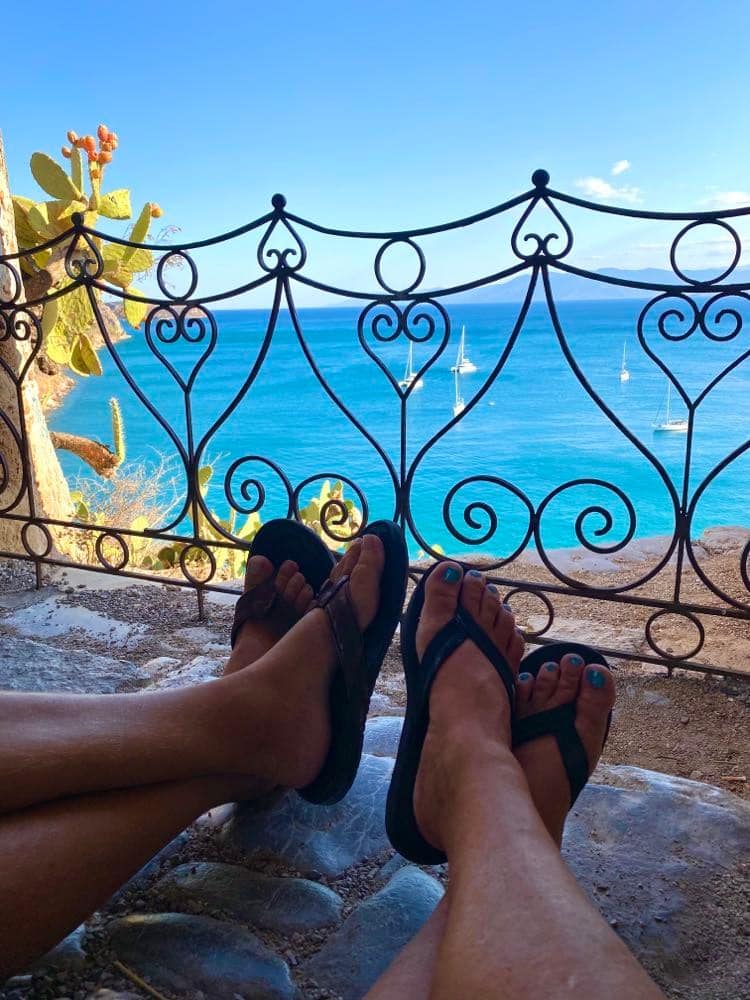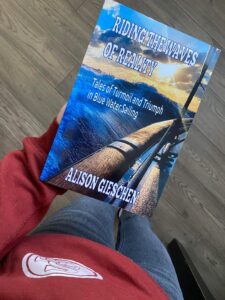Winston Churchill: “Success is not final, failure is not fatal: It is the courage to continue that counts.”
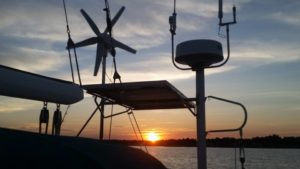
Living in a confined space, unable to leave that space for extended periods, can be challenging for even seasoned relationships. We have been liveaboards for six years. We have met many sailing couples. Several of those couples have tragically grown apart as a result of their differences while living in close quarters. Many mates have abandoned ship. Just like route planning, provisioning, and boat maintenance, there are strategies to help you keep your relationship healthy and prepare for the hardships ahead.
A Captain’s Responsibilities
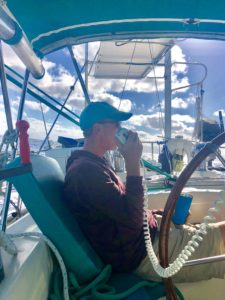
This doesn’t mean there isn’t collaboration. Collaboration is also important. However, life on a boat is very different from life on land and there needs to be a system developed, a routine, which if followed will lead to smooth sailing and pleasant voyages. When things go wrong on a boat, it isn’t a matter of if, it’s when; one person needs to be in charge.
Usually, the spouse with the most experience, with the ability to handle the boat in a crisis, is deemed the captain. The term ‘Captain” is not just a title, it’s a position of authority that will be used in many situations. For instance, if you sail into a foreign port, many countries demand that only the captain disembark from the vessel to check in the boat. The rest of the crew must remain on board. The captain will officially be listed on all the boat documentation.
When the coast guard or authorities pull you over to inspect your boat, which happens quite a bit, they will be talking to the captain. That captain is responsible for providing all the required needed documents and answering questions about the boat.
Route Planning
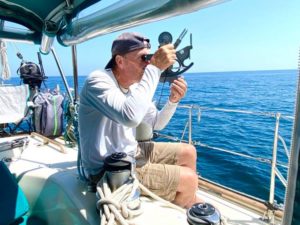
Of course, there is planning involved in the timing of the passage with the weather. Once again, the person with the most experience in currents, tides, and weather patterns should plot the course. My husband often advises me that leaving on a certain date will result in sailing in high winds and rough seas. I usually opt to wait for the best weather window so the sail will be more pleasant. My captain lets me decide on the timing as I am less experienced and dislike rough passages.
Developing a System

When we bought our boat, the couple who lived aboard Equus for nine years, handed us a pair of headsets. They told us they were leaving these for us and were called the “marriage savers.” A lot of contention arises when things start going downhill during the anchoring process. Having to yell to communicate exacerbates the situation. Instead of a suggestion, the shouting to be heard is perceived as a criticism. Things can quickly turn into an accusatory yelling match.
We have developed a clear process, after a few contentious arguments while dropping anchor, that has eliminated any miscommunication. No need for headsets.
Anchoring:
- My husband starts the engine. I turn on the necessary equipment and go to the bow to prepare the anchor.
- The captain chooses the potential anchoring site and notifies me of the depth.
- If I can see the bottom, I direct him to a spot where I think the anchor will set the best, a nice sandy spot with no rocks or grass.
- When the boat comes to a halt, I drop the anchor.
- When the anchor has been set and the chain laid out, I let him know with a thumbs up.
- He then backs down on the anchor while I watch for dragging.
- When I feel the anchor is holding, I give him the thumbs up.
- Dan then comes forward and we put on the bridle.
Pulling up the Anchor:
- Dan goes to the bow to take off the bridle, and I take the helm.
- He removes the bridle and begins taking in the anchor.
- He holds up his fingers to let me know how much anchor is left (4 fingers a hundred feet, 3 seventy-five, and so on…).
- If I need to use the engine to help when it is windy, he points in the direction I need to move forward toward. He holds up a fist to let me know to stop moving forward. He waves his hand from side to side to let me know the anchor is free.
Our anchoring system is so down pat, we got a compliment from a Frenchman watching us anchor at our last port. We are THAT good!
Create A Job Routine
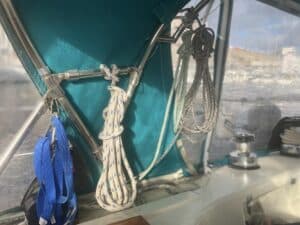
A good first mate knows not to be told to coil the lines, makes sure everything is safely stowed, and has everything the captain needs to do his job, in place. Dan will spend the day in the cockpit making sure we are safe and on course. When my tasks are completed, I can sunbathe, go below and read, or sleep. Dan will be at the helm making sure we get where we are going safely. I feed him when it is mealtime, make sure he is drinking enough water, and try to anticipate what needs to be done below deck should the weather get rough.
When we are on an extended passage, we take shifts at the helm. During the night we take three-hour watches. Dan is always ready to come up and help out if I have any concerns during my watch. Not being the bravest soul in the world, I take comfort in the fact that my captain never criticizes me or complains when I wake him up during my shift. It is the captain’s job to make sure all is safe, all is well, and I’m happy to let him have that role.
Creating Your Domain
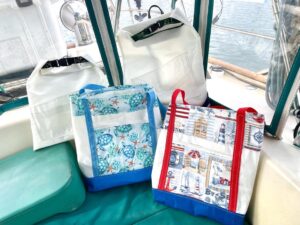
I have also established myself as the resident seamstress. This is humorous because, during my land life, I never sewed a thing. I wouldn’t even sew the patches on my boy’s scout uniforms. If I had to hem pants, I used the iron on sticky tape.
Since living aboard, I have transformed into a master seamstress. Dan purchased a Sailrite sewing machine before we left to sew a UV strip on our jib. He figured a machine on board to make sail repairs would be useful. Little did he know I would relish learning a new hobby and one that has been extremely useful during our voyage.
I paid a man to help me sew a new bimini before we left. That one project was so complex that after completing it, there wasn’t a thing I couldn’t fabricate. Since then, I’ve made dinghy covers, sail covers, sail bags, cushion covers, and engine covers, and made many sail repairs. It’s a useful hobby and has even earned us some money along the way. I collect and recycle sails that are being thrown away and make them into my own form of art. They make great gifts and keep sails out of landfills as it takes hundreds of years for them to decompose.
Learn to Make Concessions
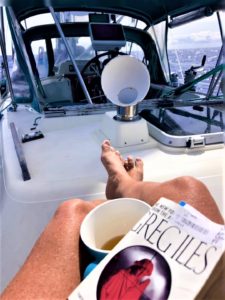
I was the master of staying angry on land. I could hold a grudge for days if I didn’t win an argument. This frame of mind doesn’t work on a boat. Everyone has their way of dealing with a disagreement. Develop a strategy for when you become frustrated and become a master.
My strategy is to think about everything I have to be thankful for such as:
- I could be living in a house with a 9 to 5 job.
- I could lose my husband overboard and then I would be on this boat alone.
- We are still healthy, still alive, and still afloat. Does anything else really matter?
- Most people would love to be doing what we are right now… don’t sweat the little stuff.
Make sure you have a good library of books on board. If you need to take your mind away from a disagreement, find a quiet place above or below deck and do some reading. Pull out your computer and write about your adventures. Go into your galley and bake something fun. You will find that after an hour or so, whatever you were disagreeing about perhaps wasn’t such a big deal.
Work on Your Perspective

You know your partner well. You know what pushes his or her buttons. You know what words or attitudes can escalate or de-escalate a situation. I often find myself at a crossroads. We might be on the edge of contention about an issue. This is when I reflect on where we are and all that we have to be thankful for. That is when I take a step back and think about how I can prevent this situation from escalating.
You have the power to make things smooth or let them get rough. You have to change your perspective from how do I get my way, to how do we move forward together. Once you practice this, it does become easier. You are a team. Creating harmony is your job. We watched too many couples who have failed to master this concept and their cruises have ended.
More than Worth the Effort

The resounding answer is, “Yes.”
Embarking on a sailing voyage and blue-water cruising is one of the most terrifying, exciting, and rewarding experiences on the planet. It is a lot of work. Things break, storms happen, and sometimes the chaos seems out of control. The one thing you do have control over is your relationship. You can make it a priority and learn to become one, a force to be reckoned with that takes on every hardship, overcomes it, and wears that experience like a badge of honor.
When you master how to work together, you become stronger. When we meet new sailing friends, ones that are experienced, we sense immediately whether they have been successful. There is an ease, confidence, respect, and a joyful glow around those who have mastered the art of living together on a boat.
On those occasions we do fly back to land to visit family, instead of enjoying our freedom, we remain inseparable. Living and working together on a boat creates a unique bond. Does it take work? Yes. Is it an easy transformation? No. Is it worth it? Yes. We are the few, the happy, the free, the one percent of humanity.
Fair winds,
Alison and Dan
S/V/ Equus
Enjoying our blog posts? Check out our newly launched book, Riding the Waves of Reality. This is the story of the first five years of our circumnavigation. There are lots of practical tips as well as the facts and realities of liveaboard sailing. This book is for anyone who loves adventure, travel, the discovery of new places, and tales of overcoming adversity. Put it on your gift list for your sailing and adventure-loving friends!


